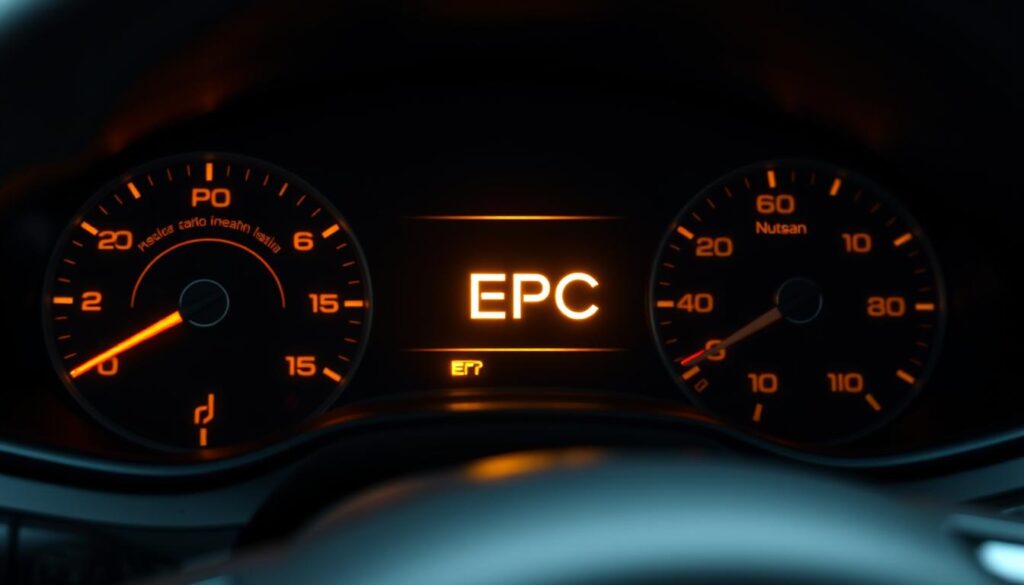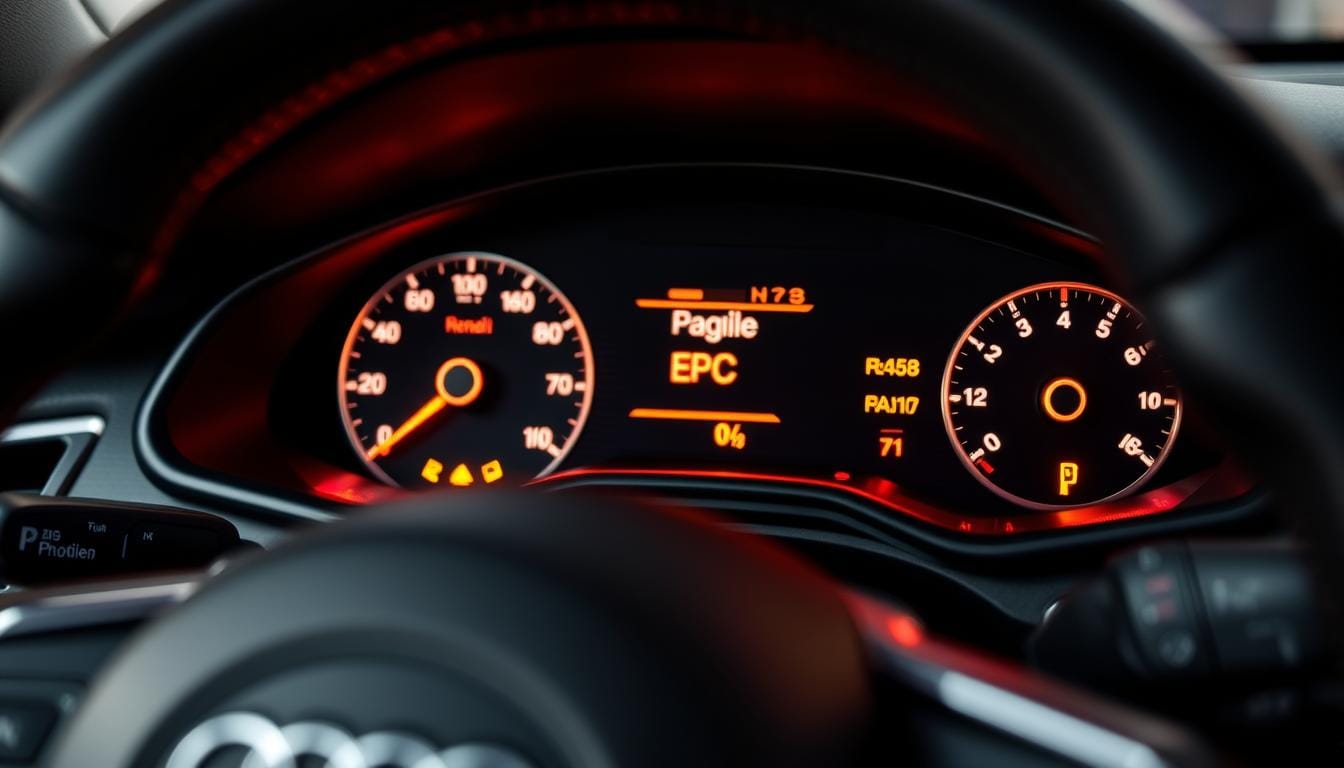EPC Light Audi: 5 Common Causes & Quick Fixes You’ll Love
Table of Contents
“An investment in knowledge pays the best interest” – Benjamin Franklin
The illumination of the Electronic Power Control (EPC) warning indicator on your vehicle’s dashboard can be a cause for concern. This warning light signifies a potential issue within your Audi’s engine management system, which controls various electronic components influencing engine performance.
Understanding the significance of this dashboard indicator is crucial for maintaining your vehicle’s health and ensuring safety on the road. The EPC system is a critical component that monitors and regulates engine and throttle functions. When this indicator illuminates, it is essential to address the issue promptly to prevent potential damage.
This guide will walk you through what the EPC light means, its causes, symptoms, and the appropriate steps to take, ensuring you’re well-equipped to handle this situation.
Understanding the EPC Light in Audi Vehicles

Audi’s Electronic Power Control (EPC) system is a sophisticated technology that manages engine performance, and its warning light can indicate several issues. The EPC system is integral to the vehicle’s operation, influencing various aspects of engine management.
What is the Electronic Power Control System?
The Electronic Power Control (EPC) system is a critical component of modern Audi vehicles. It primarily regulates the throttle body, controlling the engine’s air intake, which directly affects engine acceleration and responsiveness. A malfunction in this system can lead to performance issues.
How the EPC System Works with Your Engine
The EPC system works in tandem with the engine through various sensors that monitor parameters like air-fuel mixture, engine temperature, and crankshaft position. These sensors provide data to the Engine Control Unit (ECU), which adjusts engine functions to optimize performance. The EPC system’s real-time monitoring and adjustments ensure smooth operation and efficient power delivery.
| EPC System Component | Function |
|---|---|
| Throttle Control | Regulates air intake, affecting engine acceleration |
| Engine Sensors | Monitor engine parameters like air-fuel mixture and temperature |
| Engine Control Unit (ECU) | Processes sensor data to adjust engine functions |
Common Causes of the EPC Light Audi Warning

Understanding the common causes of the EPC light warning is essential for Audi owners to address the issue effectively. The EPC light can be triggered by various factors, including issues with the throttle body, faulty sensors, brake system problems, and electrical or wiring complications.
Throttle Body Issues
The throttle body is a critical component that regulates airflow into the engine. Throttle body issues can cause the EPC light to illuminate. Common problems include carbon buildup, faulty throttle position sensors, or electrical malfunctions within the throttle body assembly. Cleaning or replacing the throttle body can often resolve these issues.
Faulty Sensors and Their Impact
Faulty sensors can disrupt the Electronic Power Control system’s operation, leading to the EPC warning light. Sensors such as the crankshaft position sensor, camshaft position sensor, or throttle position sensor, when malfunctioning, can send incorrect signals to the ECU, triggering the warning light. Diagnosing and replacing faulty sensors can rectify this problem.
Brake System Problems
Brake system issues, including worn-out brake pads, malfunctioning ABS sensors, or problems with the brake light switch, can also trigger the EPC light. Ensuring the brake system is in good working condition is crucial. Regular maintenance and inspection of brake components can help prevent these issues.
Electrical and Wiring Complications
Electrical or wiring problems are another common cause of the EPC light warning. Damaged, corroded, or loose wiring connections can disrupt communication between the ECU and other components. Voltage irregularities due to alternator or battery issues can also affect the EPC system. Diagnosing electrical issues can be challenging and may require specialized equipment.
Symptoms That Accompany an Illuminated EPC Light
The EPC light on your Audi’s dashboard is more than just a simple warning; it’s often a signal of underlying issues that require immediate attention. When this light appears, it’s typically accompanied by other symptoms that can impact your vehicle’s performance and safety.
Engine Performance Problems
One of the common symptoms associated with an illuminated EPC light is engine performance issues. You might notice your engine running rough, misfiring, or experiencing a decrease in overall power. These problems can be due to various factors, including faulty sensors or throttle body issues, which are directly related to the EPC system.
Acceleration and Power Issues
A sudden loss of power or difficulty accelerating can be alarming, especially when accompanied by the EPC warning light. This combination often indicates a problem with the Electronic Power Control system, which could be caused by a malfunctioning throttle pedal or other related components. It’s crucial to address these issues promptly to avoid further damage.
When Multiple Warning Lights Appear Together
Sometimes, the EPC light is not the only warning sign on your dashboard; other lights like the Check Engine Light or ABS warning light may also appear. This can indicate a more complex issue that requires professional diagnosis. Modern vehicles have interconnected systems, so a single fault can trigger multiple warning lights. Understanding the pattern of these lights can help mechanics diagnose the problem more accurately.
When multiple warning lights appear simultaneously, it generally signifies a more serious issue that necessitates prompt professional attention. Ignoring these warnings can lead to more severe problems, potentially causing safety hazards or costly repairs.
Diagnosing and Fixing Your Audi’s EPC Light
The EPC light on your Audi can be a puzzling warning, but with the right guidance, you can identify and potentially resolve the issue. Diagnosing the problem involves understanding the Electronic Power Control (EPC) system and its integration with your vehicle’s engine and other components.
Using Diagnostic Tools to Read Error Codes
To diagnose EPC light issues, you’ll need a diagnostic tool to read error codes stored in your Audi’s onboard computer. These codes provide crucial information about the source of the problem, whether it’s related to the throttle body, sensors, or other components.
Step-by-Step Troubleshooting Process
A systematic approach to troubleshooting is essential. Start by checking the most common causes, such as throttle body issues or faulty sensors, and work your way through more complex potential problems.
When to Attempt DIY Fixes
If you’re comfortable with basic car repairs and have the necessary tools, you may be able to fix simple issues like cleaning or replacing a faulty sensor. However, more complex problems require professional attention.
Professional Repair Options and Costs
For complex issues or if you’re unsure about the diagnosis, consult a professional mechanic. They can provide a detailed quote based on your vehicle’s condition and required repairs. The cost to repair the EPC light can vary widely, from simple repairs like sensor replacements to more complex fixes involving the throttle body or electrical system.
Conclusion: Maintaining Your Audi’s Electronic Systems
Understanding and addressing the EPC light promptly can save you from more severe issues down the road. The EPC light is an indicator of potential problems with your Audi’s electronic power control system, which can impact engine performance and safety.
To avoid EPC light issues, adhere to regular service intervals and use quality fuel. Proper driving habits also play a crucial role in maintaining your vehicle’s electronic systems. By doing so, you can reduce the likelihood of encountering EPC warnings. If the EPC light comes on, have your vehicle inspected as soon as possible to prevent further complications.
Developing a good relationship with a trusted Audi service provider can help in diagnosing and repairing issues efficiently. With proper maintenance, you can ensure your Audi continues to perform reliably. Your car may still operate when the EPC light is on, but it’s not advisable to continue driving. Prompt action will help maintain your Audi’s performance and reliability for years to come.

